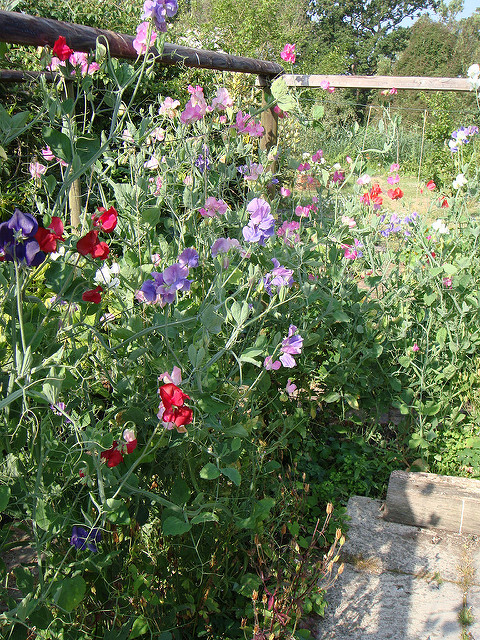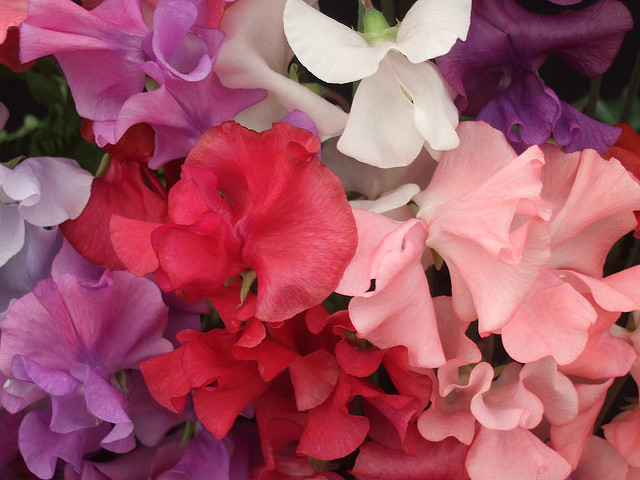
Image: SatrinaO (Flickr)
Just like growing your own veggies, growing your own flowers is another way you can reduce your carbon footprint and connect with seasonal produce. The cut flower industry often uses artificial lighting, refrigerated transport, and a high volume of pesticides to produce blooms. At home you can grow your own organic flowers and avoid excessive energy consumption.
I remember reading a book by Jackie French, who said that she would always feel wealthy if she had flowers to pick from her garden. This struck a chord with me. I love having flowers and greenery in the house so much that sometimes I even just snip off some of my viburnum hedge and place the stems in a vase.
Sweet peas are an easy annual you can plant right now, and I love them for their beautiful fragrance and colourful, ruffled blooms that make great cut flowers.

Image: Katia Strieck (Flickr)
Ground or container planting
Traditionally sweet peas are climbing plants but if you don’t have room in the ground you can grow some dwarf sweet peas in a container or hanging basket.
Choose a scented variety
Many large flowering modern cultivars don’t have any fragrance so check the packet before you purchase your seeds. Long-stemmed Gawler cultivars are said to be the most fragrant.
Prepare your soil
Sweet peas prefer a light, friable soil that is slightly alkaline (pH between 7.0 to 8.5).
If you have heavy clay soil add gypsum and organic matter, and if your soil is too acid add lime. Consider raised beds or mounded soil if your drainage is poor.

Image: mercedesbbl (Flickr)
Provide some support
Most sweet peas are climbing plants growing around 2 metres so you’ll need to provide them with something to climb on. Gently tie them to your trellis when they are big enough to reach it then tie any stalks that need some extra support.
Sow at the optimum time
The optimum germination temperature for sweet peas is 15-20°C and in Australia sweet peas can generally be planted February, March and April. In cool climates the ideal time is around March 17th (St Patricks Day) while March 17th until April 25th (Anzac Day) is most ideal for warmer climates.
There is tradition that sweet peas should be sown before sunrise on St Patricks day to obtain the largest and most fragrant blooms and this is a nice way of remembering the timing.
Soak in water overnight or nick seed coat gently on the opposite side to the eye to aid germination.
Plant seeds 20cm apart and 2.5cm deep. Seedlings will emerge in around 10-14 days and flowering will occur around 12 to 14 weeks. If you would like to encourage a bushier plant, you can pinch out the tip to encourage side shoots.
Mulch in cool areas
Sweet peas can withstand frosty conditions as long as temperatures don’t fall below -6°C. In cool areas plant your seeds in a warm sunny spot then keep the area protected by mulching or growing a ground cover around the base of the plants.
Water lightly at first
Initially water plants lightly so that they develop strong deep tap roots then increase watering once your sweet peas have reached a height of 15-20cm. Apply seaweed extract every 3 weeks.

Image: JuniperJungle (Flickr)
Pick flowers
Regularly pick your blooms and remove spent flowers to encourage new flowers to develop. It’s lovely to be able to bring a friend fresh flowers that you grown yourself.
Rotate your beds
Sweet peas are members from the legume family, and these special plants have nitrogen forming nodules on their roots. These not only produce food for the plants but also fix nitrogen in your soil. Once your plants have died down, let the roots naturally decompose to keep the nitrogen in the soil. Rotate where you plant your sweet peas every three years because they won’t flower as well if the nitrogen levels get too high.
Keep copper away
Avoid using copper-based fertilisers or sprays or copper wire as these will kill the rhizobium (nitrogen-forming nodules) on the roots which will lead to the death of the plant.
Where can I buy seeds?
Go to your local nursery or search for seed stores online. Try to buy seeds that have been grown in Australia. You could also join a local savers group.
Have you grown sweet peas? What are your favourite varieties? Do you have any growing tips?

I am an aspiring florist, and learning through online guidelines is my way to be the very florist in Slacks Creek. Those flowers are really awesome and seem they are really taken care of properly. Thank you for sharing your insights about sweet peas. Will try to plant some on my garden and follow your guide.
The most beautiful sweet peas I’ve seen so far on the internet. How lovely they are. You did an amazing job creating these beautiful flowers.
Beautiful post. I grow the Mammoth variety directly in large pots in fresh potting mix in my sunny north facing courtyard in Melbourne. That gives me stunning results.
Your advice rings so true, often doing things instinctively and simply in the garden is the best. Too much tricked up stuff is not necessary.
The pics in your post are delightful.
Thank you for the pleasure.
Wishing you the best,
Mary